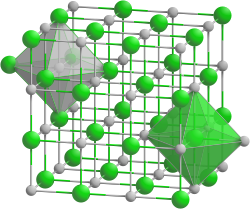
Summary
Europium(II) oxide (EuO) is a chemical compound which is one of the oxides of europium. In addition to europium(II) oxide, there is also europium(III) oxide and the mixed valence europium(II,III) oxide.

| |
| Names | |
|---|---|
| IUPAC name
Europium(II) oxide
| |
| Other names
Europium monoxide
| |
| Identifiers | |
| |
3D model (JSmol)
|
|
| ECHA InfoCard | 100.031.497 |
| EC Number |
|
PubChem CID
|
|
CompTox Dashboard (EPA)
|
|
| |
| |
| Properties | |
| EuO | |
| Molar mass | 167.963 g/mol |
| Appearance | Violet crystals[1] |
Except where otherwise noted, data are given for materials in their standard state (at 25 °C [77 °F], 100 kPa).
Infobox references
| |
Preparation edit
Europium(II) oxide can be prepared by the reduction of europium(III) oxide with elemental europium at 800 °C and subsequent vacuum distillation at 1150 °C.[2]
- Eu2O3 + Eu → 3 EuO
It is also possible to synthesize from the reaction of europium oxychloride and lithium hydride.[3]
- 2 EuOCl + 2 LiH → 2 EuO + 2 LiCl + H2
In modern research, thin films can be manufactured by molecular beam epitaxy directly from europium atoms and oxygen molecules. These films have contamination of Eu3+ of less than 1%.[4][5]
Properties edit
Europium(II) oxide is a violet compound as a bulk crystal and transparent blue in thin film form. It is unstable in humid atmosphere, slowly turning into the yellow europium(II) hydroxide hydrrate and then to white europium(III) hydroxide.[3] EuO crystallizes in a cubic sodium chloride structure with a lattice parameter a = 0.5144nm. The compound is often non-stoichiometric, containing up to 4% Eu3+ and small amounts of elemental europium.[6] However, since 2008 high purity crystalline EuO films can be created in ultra high vacuum conditions. These films have a crystallite size of about 4 nm.[citation needed]
Europium(II) oxide is ferromagnetic with a Curie Temperature of 69.3 K. With the addition of about 5-7% elemental europium, this increases to 79 K.[2] It also displays colossal magnetoresistance, with a dramatic increase in conductivity below the Curie temperature. One more way to increase the Curie temperature is doping with gadolinium, holmium, or lanthanum.[6]
Europium(II) oxide is a semiconductor with a band gap of 1.12 eV.[6]
Applications edit
Because of the properties of europium(II) oxide, thin layers of the oxide deposited on silicon are being studied for use as spin filters. Spin filter materials only allow electrons of a certain spin to pass, blocking electrons of the opposite spin.[7]
References edit
- ^ McGill, Ian (2000-06-15), "Rare Earth Elements", Ullmann's Encyclopedia of Industrial Chemistry, Weinheim, Germany: Wiley-VCH Verlag GmbH & Co. KGaA, doi:10.1002/14356007.a22_607, ISBN 3527306730
- ^ a b Shafer, M. W. (1965). "Preparation and Crystal Chemistry of Divalent Europium Compounds". Journal of Applied Physics. 36 (3). AIP Publishing: 1145–1152. Bibcode:1965JAP....36.1145S. doi:10.1063/1.1714142. ISSN 0021-8979.
- ^ a b Baudler, Marianne (1978). Handbuch der präparativen anorganischen Chemie (in German). Stuttgart: Enke. p. 1092. ISBN 3-432-87813-3. OCLC 310719490.
- ^ Sutarto, R.; Altendorf, S. G.; Coloru, B.; Moretti Sala, M.; Haupricht, T.; et al. (2009-05-21). "Epitaxial and layer-by-layer growth of EuO thin films on yttria-stabilized cubic zirconia (001) using MBE distillation". Physical Review B. 79 (20): 205318. arXiv:0902.0330. Bibcode:2009PhRvB..79t5318S. doi:10.1103/physrevb.79.205318. ISSN 1098-0121. S2CID 97016104.
- ^ Altendorf, S. G.; Efimenko, A.; Oliana, V.; Kierspel, H.; Rata, A. D.; Tjeng, L. H. (2011-10-28). "Oxygen off-stoichiometry and phase separation in EuO thin films". Physical Review B. 84 (15). American Physical Society (APS): 155442. Bibcode:2011PhRvB..84o5442A. doi:10.1103/physrevb.84.155442. ISSN 1098-0121.
- ^ a b c Santos, Tiffany S. (2008-11-10). Europium oxide as a perfect electron spin filter. DSpace@MIT Home (Thesis). Massachusetts Institute of Technology. hdl:1721.1/39538. Retrieved 2022-01-23.
- ^ Caspers, C.; Müller, M.; Gray, A. X.; Kaiser, A. M.; Gloskovskii, A.; Fadley, C. S.; Drube, W.; Schneider, C. M. (2011-10-12). "Electronic structure of EuO spin filter tunnel contacts directly on silicon" (PDF). Physica Status Solidi RRL. 5 (12). Wiley: 441–443. Bibcode:2011PSSRR...5..441C. doi:10.1002/pssr.201105403. ISSN 1862-6254. S2CID 22764388.


